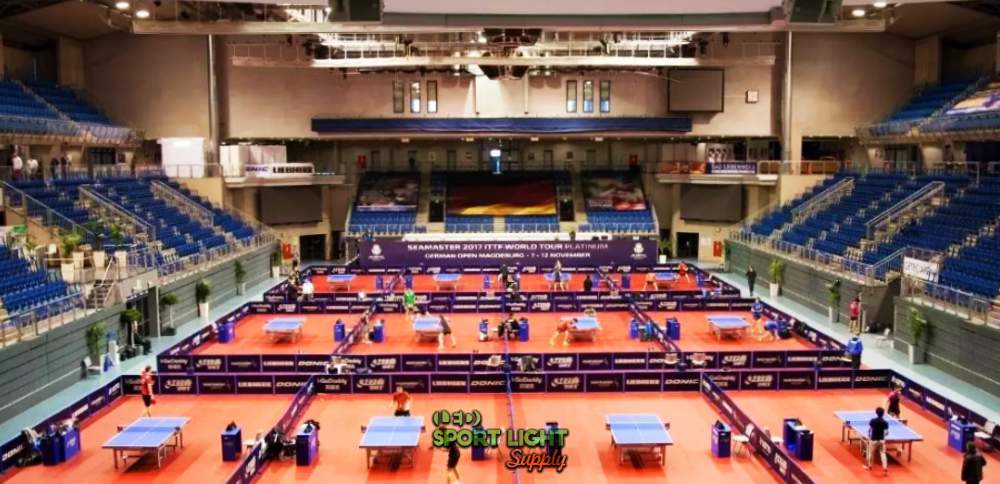When setting up lighting for a table tennis room, one of the key considerations is determining the appropriate height for the lighting fixtures. The height at which the lights are installed can significantly impact the quality of illumination, affecting both visibility and the comfort of the players. If the lights are hung too high, the room may not be adequately illuminated, making it difficult to play effectively. On the other hand, if the lights are installed too close to the table, they can create excessive glare, which can strain the eyes of the players. So, what is the ideal height for table tennis lighting?
Table of Contents
ToggleImportance of Lighting Height
The height of lighting fixtures plays a crucial role in ensuring that the table tennis room is well-lit. The appropriate height not only provides sufficient brightness but also helps in minimizing glare, which can be distracting and uncomfortable for players. Proper lighting enhances the visibility of the ball, allowing for better gameplay and reducing the risk of eye strain. Therefore, selecting the correct height for the lights is essential for creating an optimal playing environment.
Factors Influencing Lighting Height
The required height of the lighting fixtures largely depends on the level of competition. Different levels of play, from recreational to international tournaments, have varying lighting needs. The following table provides a general guideline for the recommended height based on the level of competition.
| Level of Competition | Height of Lighting |
|---|---|
| Recreational Play | 10 ft (3 m) |
| Regional Competitions | 10 ft (3 m) |
| National Tournaments | Above 13 ft (4 m) |
| International Tournaments | Above 16.4 ft (5 m) |
As seen in the table, the ceiling height requirement increases with the level of competition. Higher ceilings and more elevated lighting fixtures are necessary for professional and international tournaments, such as the Olympic Games and the Table Tennis World Cup. These elevated lights help ensure that the entire playing area is evenly illuminated without causing discomfort to the players.
Lighting for Recreational and Regional Play
For recreational play and regional competitions, a lighting height of around 10 feet (3 meters) is generally sufficient. This height provides adequate brightness for casual play and smaller tournaments without causing excessive glare. It is an ideal height for home setups, such as in garages or basements, where space may be limited.
When installing lights in a home setting, such as a garage or basement, it’s important to ensure that there is at least 10 feet (3 meters) between the lights and the ping pong table. This distance helps to create a comfortable and well-lit environment for recreational play.
Considerations for National and International Competitions

For national tournaments, the recommended height increases to above 13 feet (4 meters), while international tournaments require lighting fixtures to be placed even higher, at above 16.4 feet (5 meters). These elevated lighting positions help ensure that the entire playing area is evenly lit, providing optimal visibility for players and minimizing shadows that could interfere with gameplay.
In high-level competitions, the quality of lighting is critical. The higher the lights, the more uniform the distribution of light across the table. This uniformity is essential for professional players who rely on precise visual cues to perform at their best. Additionally, higher lights reduce the risk of glare, which can be particularly problematic in fast-paced games where quick reflexes are essential.
Addressing Glare and Ceiling Height Limitations
Glare is a common issue in table tennis lighting, especially when the lights are placed too close to the table. The reflective surface of the ping pong table can amplify glare, causing discomfort and reducing the visibility of the ball. Although glare can be minimized by carefully positioning the lights, it is still a concern in setups with lower ceilings.
If the ceiling height of your garage or basement is not high enough to achieve the recommended lighting height, there are solutions to consider. One option is to use slim panel lights that require less vertical space. Slim panel lights can be installed closer to the ceiling, maximizing the distance between the lights and the table while still providing adequate illumination. This approach helps to reduce glare and create a more comfortable playing environment, even in rooms with lower ceilings.
Creating the Ideal Lighting Setup
To create the ideal lighting setup for your table tennis room, it’s important to consider both the height of the lighting fixtures and the type of lights used. Ensuring that the lights are installed at the correct height for the level of play will enhance the overall experience, whether you are setting up a recreational space or preparing for high-level competition. Additionally, selecting lights that minimize glare and provide uniform illumination will further improve the quality of play, making your table tennis room a more enjoyable and professional environment.
By paying attention to these factors, you can create a lighting setup that meets the needs of players at all levels, from casual enthusiasts to professional athletes. Whether you’re setting up lights in your garage or designing a venue for international tournaments, the right lighting height will contribute significantly to the success of the game.
Conclusion
Properly positioned lights enhance visibility and reduce glare, which is crucial for both recreational and competitive play. By aligning the lighting height with the level of competition and addressing potential issues such as glare and ceiling limitations, you can create an ideal setup that meets the needs of players at every level. Whether you’re setting up a home space or preparing for a major tournament, thoughtful lighting design will contribute significantly to a better and more enjoyable table tennis experience.
